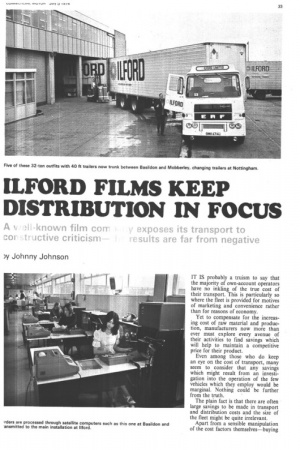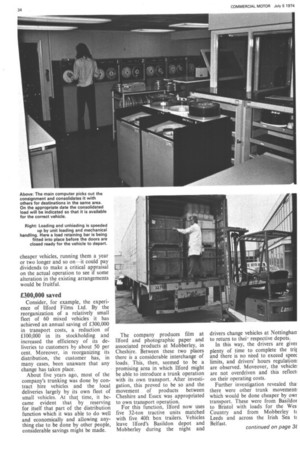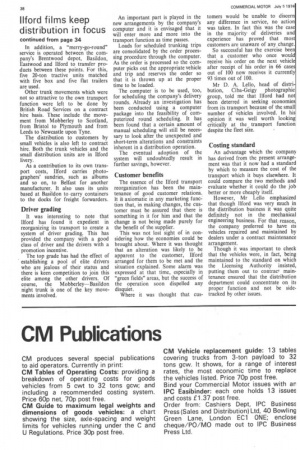ILFORD FILMS KEEP DISTRIBUTION IN FOCUS
Page 35

Page 36

Page 40

If you've noticed an error in this article please click here to report it so we can fix it.
A 14 h-known film con-i v exposes its transport to
cor tructive criticism— results are far from negative
IT IS probably a truism to say that the majority of own-account operators have no inkling of the true cost of their transport. This is particularly so where the fleet is provided for motives of marketing and convenience rather than for reasons of economy.
Yet to compensate for the increasing cost of raw material and production, manufacturers now more than ever must explore every avenue of their activities to find savings which will help to maintain a competitive price for their product.
Even among those who do keep an eye on the cost of transport, many seem to consider that any savings which might result from an investigation into the operation of the few vehicles which they employ would be marginal. Nothing could be further from the truth.
The plain fact is that there are often large savings to be made in transport and distribution costs and the size of the fleet might be quite irrelevant.
Apart from a sensible manipulation of the cost factors themselves—buying
£300,000 saved
Consider, for example, the experience of Ilford Films Ltd. By the reorganization of a relatively small fleet of 60 mixed vehicles it has achieved an annual saving of £300,000 in transport costs, a reduction of £100,000 in its stockholding and increased the efficiency of its deliveries to customers by about 50 per cent. Moreover, in reorganizing its distribution, the customer has, in many cases, been unaware that any change has taken place.
About five years ago, most of the company's trunking was done by contract hire vehicles and the local deliveries largely by its own fleet of small vehicles. At that time, it became evident that by reserving for itself that part of the distribution function which it was able to do well and economically and allowing anything else to be done by other people, considerable savings might be made. The company produces film at Ilford and photographic paper and associated products at Mobberley, in Cheshire. Between these two places there is a considerable interchange of loads. This, then, seemed to be a promising area in which Ilford might be able to introduce a trunk operation with its own transport. After investigation, this proved to be so and the movement of products between Cheshire and Essex was appropriated to own transport operation.
For this function, Ilford now uses five 32-ton tractive units matched with five 40ft box trailers. Vehicles leave Ilford's Basildon depot and Mobberley during the night and drivers change vehicles at Nottinghan to return to theirespective depots.
In this way, the drivers are givex plenty of time to complete the air and there is no need to exceed spee( limits, and drivers' hours regulation; are observed. Moveover, the vehicle; are not overdriven and this reflect; on their operating costs.
Further investigation revealed tha there were other trunk movement; which would be done cheaper by owr transport. These were from Basildot to Bristol with loads for the Wes Country and from Mobberley t( Leeds and across the Irish Sea t( Belfast. In addition, a "merry-go-round" service is operated between the company's Brentwood depot, Basildon, Eastwood and Ilford to transfer products between these points. For this, five 20-ton tractive units matched with five box and five flat trailers are used.
Other trunk movements which were not so attractive to the own transport function were left to be done by British Road Services on a contract hire basis. These include the movement from Mobberley to Scotland, from Bristol to Plymouth and from Leeds to Newcastle upon Tyne.
The distribution to customers by small vehicles is also left to contract hire. Both the trunk vehicles and the small distribution units are in Ilford livery.
As a contribution to its own transport costs, Ilford carries photographers' sundries, such as albums and so on, to Belfast for another manufacturer. It also uses its units based at Basildon to carry containers to the docks for freight forwarders.
Driver grading It was interesting to note that Ilford has found it expedient in reorganizing its transport to create a system of driver grading. This has provided the company with a good class of driver and the drivers with a promotion incentive.
The top grade has had the effect of establishing a pool of elite drivers who are jealous of their status and there is keen competition to join this elite among the other drivers. Of course, the Mobberley—Basildon night trunk is one of the key movements involved. An important part is played in the new arrangements by the company's computer and it is envisaged that it will enter more and more into the transport function as time passes.
Loads for scheduled trunking trips are consolidated by the order processing procedure through the computer. As the order is processed so the computer picks out the appropriate vehicle and trip and reserves the order so that it is thrown up at the proper time to be loaded.
The computer is to be used, too, for scheduling the company's delivery rounds. Already an investigation has been conducted using a computer package into the feasibility of computerized round scheduling. It has been found that a certain amount of manual scheduling will still be necessary to look after the unexpected and short-term alterations and constraints inherent in a distribution operation.
The eventual adoption of the system will undoubtedly result in further savings, however.
Customer benefits The essence of the Ilford transport reorganization has been the maintenance of good customer relations. It ig axiomatic in any marketing function that, in making changes, the customer must be, assured that there is something in it for him and that the change is not being made purely for the benefit of the supplier.
This was not lost sight of in considering how the economies could be brought about. Where it was thought that an alteration was likely to be apparent to the customer, Ilford arranged for them to be met and the situation explained. Some alarm was expressed at that time, especially in "green fields" areas, but the success of the operation soon dispelled any disquiet.
Where it was thought that cus tomers would be unable to discern any difference in service, no action was taken. In fact this was the case in the majority of deliveries and experience has proved that most customers are unaware of any change.
So successful has the exercise been that a customer who once would receive his order on the next vehicle after receipt of his order in 66 cases out of 100 now receives it currently 93 times out of 100.
Mr D. A. Lello, head of distribution, Ciba-Geigy photographic group, told me that Ilford had not been deterred in seeking economies from its transport because of the small number of vehicles involved. In his opinion it was well worth looking critically at the transport function despite the fleet size.
Costing standard An advantage which the company has derived from the present arrangement was that it now had a standard by which to measure the cost of the transport which it buys elsewhere. It could compare the two methods and evaluate whether it could do the job better or more cheaply itself.
However, Mr Lello emphasized that though Ilford was very much in the distribution business it was quite definitely not in the mechanical engineering business. For that reason, the company preferred to have its vehicles repaired and maintained by dealers under a contract maintenance arrangement.
Though it was important to check that the vehicles were, in fact, being maintained to the standard on which the Licensing Authority insisted, putting them out to contract maintenance ensured that the distribution department could concentrate on its proper function and not be sidetracked by other issues.
























































































































































